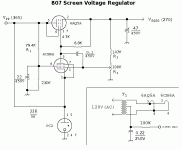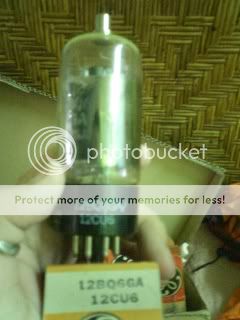coresta said:Yes, just add some OA2 or OB2 in screen, these are more sexy than zenersand look at AudioResarch or ... Western Electric schematics
Happy listening

Here is what I built for a project.
Attachments
Shoog said:This configuration works very well ala the RH807. It works so well infact, you can forget the screen regulation and simply strap it to the plate. You can also expect a lower output impedance than a triode strapped 807.
Shoog,
I know what an 807 is but what is a RH807 ????
Sure wish had some of those 1624's to work with! I suspect they'd be a delicious sounding driver into an I.T. strapped as a triode with DC heat. I did this with a 1619 in my 809 A2 SET amp and it has real magic tone but the metal bottle doesn't have the same sex appeal of a glass ST bulb.
rcavictim said:
I know what an 807 is but what is a RH807 ????
Follow the link:
http://www.tubeaudio.8m.com/807/807.html
hey-Hey!!!,
The 1624 is quite similar to type 1619. The 1619 is DH( at 2.0A/2.5V) and behaves more like a 6V6 than a 6L6. It has more plate dissipation, but since we can't see through the steel bottle, running it to its maximum ratings is not a good idea. I found the 1619 happiest at around 16W plate dissipation. The 1624 data also ref's the 1619 curves and they're quite different from a 6L6/807 set.
cheers,
Douglas
The 1624 is quite similar to type 1619. The 1619 is DH( at 2.0A/2.5V) and behaves more like a 6V6 than a 6L6. It has more plate dissipation, but since we can't see through the steel bottle, running it to its maximum ratings is not a good idea. I found the 1619 happiest at around 16W plate dissipation. The 1624 data also ref's the 1619 curves and they're quite different from a 6L6/807 set.
cheers,
Douglas
Bandersnatch said:hey-Hey!!!,
The 1624 is quite similar to type 1619. The 1619 is DH( at 2.0A/2.5V) and behaves more like a 6V6 than a 6L6. It has more plate dissipation, but since we can't see through the steel bottle, running it to its maximum ratings is not a good idea. I found the 1619 happiest at around 16W plate dissipation. The 1624 data also ref's the 1619 curves and they're quite different from a 6L6/807 set.
cheers,
Douglas
As a driver I am running my 1619's easy and at only 200 volts, and also slightly starved filament as well. Steve Bench did some tests on this tube and discovered that the THD dropped to vanishing levels in starved filament mode. Finding non-microphonics out of my small batch of NOS was a challenge however. These were designed as a push-to-talk RF transmitter tube with cold filament between gabs to save the batteries.
I wanted all DHT in my SET amp adventure without spending money on boutique or mainstream DH triodes.
Bandersnatch said:The 1624 data also ref's the 1619 curves and they're quite different from a 6L6/807 set.
That's the whole point. The 1624 is not a DH 807, despite your seeing that claim all the time. As an audio final, the 1619/1624 doesn't work so swell in Class AB1. At Vpp= 600Vdc, Vsgsg= 300Vdc, the Vgk= 0 line hits the plate cuirrent at less than 100mA. Drawing a Class AB1 loadline, I got something like 10W of output, which is ridiculous for the operating voltages. Keeping that plate current down was desireable for a type that was probably going to be running in Class B or Class C since it can be cut off without excessive grid bias.
From the 1624 spec sheet:
Driver stage should be capable of supplying the grids of the Class AB2 stage with the specified peak grid voltage at low distortion. The effective resistance per grid should be below 500R and the highest effective impedance at the highest desired resonse frequency should not exceed 700R. [...]
With zero impredance driver and perfect regulation plate circuit distortion does not exceed 2.0%
This is obviously one of those RF types designed for a specific RF application that also happened to have decent linearity for audio. However, it only works as a Class AB2. Of course, zero drive impedance and perfect regulation is not exactly practical. This statement does, however, point the way: use a MOSFET source follower and you'll get closer than was ever possible back when this type was designed.
If you need the ~80W that this type and the Class AB2 807 can produce, it's not a bad way to go.
Besides, 1624s have that funky retro look, and the glowey bottle goodness.
Bandersnatch said:hey-Hey!!!,
The 1624 is quite similar to type 1619. The 1619 is DH( at 2.0A/2.5V) and behaves more like a 6V6 than a 6L6. It has more plate dissipation, but since we can't see through the steel bottle, running it to its maximum ratings is not a good idea. I found the 1619 happiest at around 16W plate dissipation. The 1624 data also ref's the 1619 curves and they're quite different from a 6L6/807 set.
cheers,
Douglas
i thought no one would point this out...been watching this thread closely as i have sources of these tubes....
Hi Douglas,
the datasheet for the 1619 and 1624 shows operating points for class AB2, are these tried and tested?
Also, like in the case of 4D32, class AB2 seems to shows lower distortion percentage, any comments please....thanks...
Tony said:the datasheet for the 1619 and 1624 shows operating points for class AB2, are these tried and tested?
Yes. There are lots of 1624-based designs out there. Some good; some not so good. But, yeah, it's been done lots of times.
Also, like in the case of 4D32, class AB2 seems to shows lower distortion percentage, any comments please....thanks...
The 1624 is similar to the 807 in that it does produce some of the lowest THD figures of any pentode even before you connect the NFB. I would expect that the 1624 is like the 807 in another regard: that possibly it likes to make high order distortion. When I did a PP 807 amp, the Twin-T test I did showed that the advertised THD spec was dead on. However, the residual after nulling was considerably distorted, meaning that there was a lot of h5 and higher in there.
Listening open loop revealed that there was considerable pentode nastiness in the background. With some program material (i.e. Ozzy's Bark at the Moon) it rose to fingernails on the blackboard irritating. With all program material, there was inevitable listener fatigue even if the nastiness wasn't obviously audible.
After a week of open loop listening, I figured that the finals could benefit from local NFB (as O. Schade recommends: feedback 10% of the plate Vp back to the input side). That cleared things up considerably, and only another 6.0db(v) of gNFB was needed to make for a fine sounding amp.
By contrast, some types make a lot more THD, but it's all h3. I found this to be the case with 6BQ6GTBs: about 3.0% THD, but in the Twin-T test, it looks almost completely sinusoidal with maybe a trace of h5 or higher. Listening to these open loop doesn't give any pentode nastiness, just an overly "aggressive" or "edgy" sound (and, of course, sloppy bass due to woofer underdamping). That project wound up with 12db(v) of gNFB, adjustable. Sounds best with about 6.0db(v) dialed in since the whole 12db(v) sounds a bit "solid statey" (although good for some types of music, but hard rock definitely sounds "subdued"). No need for local NFB with 6BQ6GTBs (or 6V6s for that matter -- another type that produces mainly h3).
^^^^
I have a couple of the 6BQ6GTAs. These sound the same, but don't seem to be as robust. Running the 6BQ6GTBs with 50mA of Ip per tube gives a Pd= 17.5W (12W rated) and no red plate when viewed in the dark (RCA grey plates; the Sylvania black plates took up to 70mA without showing color, the RCAs glowed faintly at that plate current) The 6BQ6GTAs, however, red plated at 50mA of plate current. Sounded just as good, but probably wouldn't last as long running that hot.
When using the 'GTAs, probably best not to exceed the plate dissipation spec. Of course, that won't sound as good since it'll be closer to Class B. Running the GTBs hot definitely helped the sonics.
Can't say about those GAs. From the pic, those definitely have a fatter bottle than the GT versions. With the GTs, the glass fits completely in the black plastic octal bases.
Yeah, 6BQ6GTBs are cheeeeeeeeep for what you get. Although we keep talkin' 'em up and they'll get more expensive. The 12.6 volt versions will be even cheaper still due to the odd voltage.
I have a couple of the 6BQ6GTAs. These sound the same, but don't seem to be as robust. Running the 6BQ6GTBs with 50mA of Ip per tube gives a Pd= 17.5W (12W rated) and no red plate when viewed in the dark (RCA grey plates; the Sylvania black plates took up to 70mA without showing color, the RCAs glowed faintly at that plate current) The 6BQ6GTAs, however, red plated at 50mA of plate current. Sounded just as good, but probably wouldn't last as long running that hot.
When using the 'GTAs, probably best not to exceed the plate dissipation spec. Of course, that won't sound as good since it'll be closer to Class B. Running the GTBs hot definitely helped the sonics.
Can't say about those GAs. From the pic, those definitely have a fatter bottle than the GT versions. With the GTs, the glass fits completely in the black plastic octal bases.
Yeah, 6BQ6GTBs are cheeeeeeeeep for what you get. Although we keep talkin' 'em up and they'll get more expensive. The 12.6 volt versions will be even cheaper still due to the odd voltage.
- Status
- This old topic is closed. If you want to reopen this topic, contact a moderator using the "Report Post" button.
- Home
- Amplifiers
- Tubes / Valves
- 807 vs. 1624 tetrode ?



